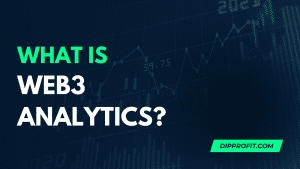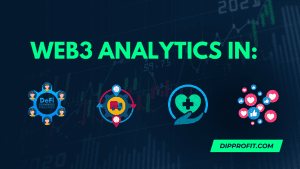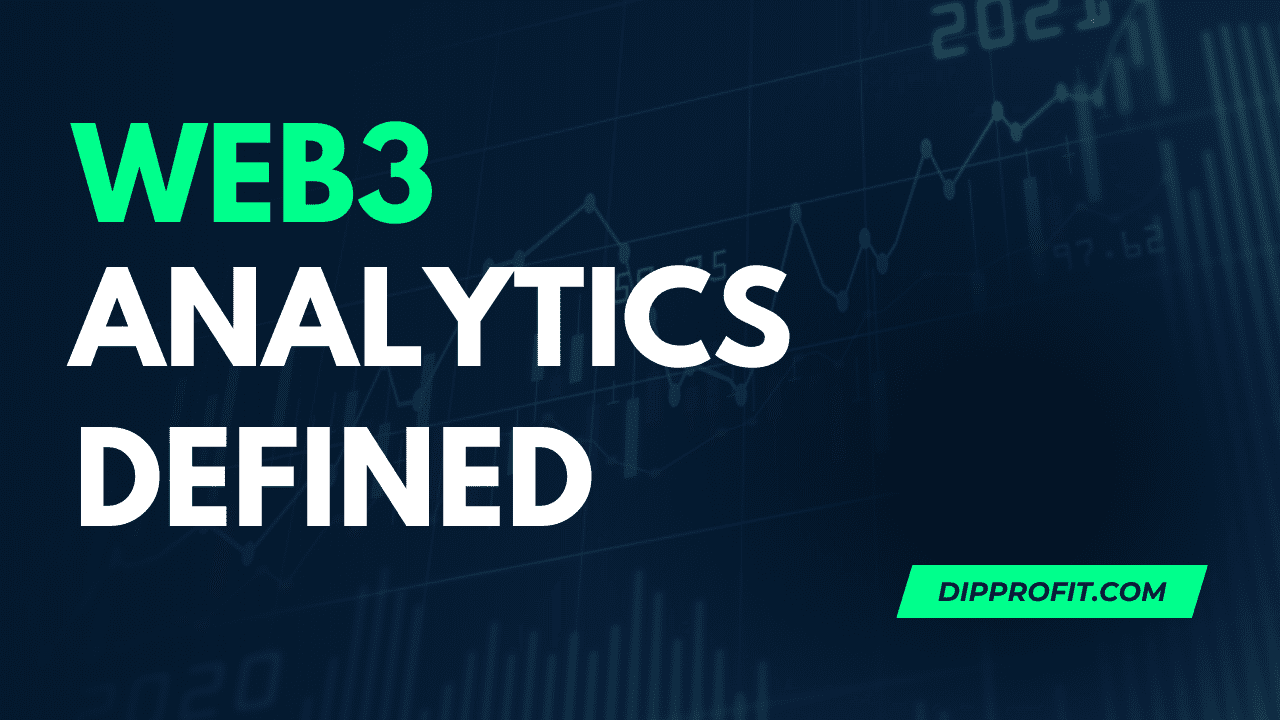Web3 analytics is an increasingly important area of data science that is gaining traction in the world of digital marketing and technology.
By leveraging data from the decentralized web, web3 analytics provides a powerful new set of insights and capabilities for marketers and developers alike.
In this blog post, we will explore what web3 analytics are, why they are important, how they work, and what types of analytics should be considered when utilizing web3 data.
With a better understanding of web3 analytics, businesses can make better decisions and gain a competitive edge in the rapidly changing digital landscape.
What is Web3 Analytics?

Web3 analytics refers to the practice of collecting and analyzing data related to web interactions in the decentralized web environment known as Web3. This includes information about user behavior, website performance, and other key metrics that provide insights into the effectiveness and success of online platforms and applications.
Unlike traditional web analytics, which is focused on centralized websites and applications, Web3 analytics cover a broader scope, considering the unique characteristics of decentralized platforms and technologies.
It takes into account all factors such as blockchain transactions, decentralized identity, smart contracts, and other Web3-specific features.
By leveraging Web3 analytics, developers and businesses can gain a deeper understanding of how their decentralized platforms are being used and make informed decisions to enhance user experiences, optimize performance, and drive growth.
These insights can help identify patterns, trends, and opportunities that might otherwise go unnoticed, ultimately leading to more efficient and effective development and deployment of Web3 applications.
In summary, Web3 analytics is a powerful tool that enables businesses and developers to navigate and leverage the decentralized web environment by gaining valuable insights into user behavior and platform performance. By harnessing the potential of Web3 analytics, organizations can stay ahead of the curve and thrive in the ever-evolving world of decentralized technologies.
Why Does Web3 Matter?
To understand why Web3 matters, let’s take a quick trip back in time. The internet has come a long way since its early days when it started as a way to connect computers and share information. Then, it transformed into a platform for communication, entertainment, and online shopping. But now, it’s ready for its next big leap.
Web3 analytics is the next generation of web analytics that focuses on the decentralized web, also known as Web3. In simple terms, Web3 refers to the vision of a more open, transparent, and user-centric Internet. It leverages blockchain technology to empower individuals, enhance privacy, and enable peer-to-peer transactions without the need for intermediaries.
But what exactly is Web3 analytics and why is it important? Web3 analytics refers to the collection, measurement, and analysis of data related to user interactions, behaviors, and trends within Web3 applications and platforms. It provides valuable insights to developers, businesses, and individuals about the usage, performance, and effectiveness of their decentralized applications (dApps) and smart contracts.
See also: How Can a Web3 Agency Help Grow Your Business?
The Importance of Web3 Analytics

Web analytics play a crucial role in helping businesses understand how their website is performing. With the rise of web3 technology, web3 analytics have become even more important.
Traditionally, the work of analytics is to provide information on user behavior, such as which pages are visited most frequently and where users are coming from. This data can be used to improve the website’s user experience and to make informed business decisions.
Without analytics, businesses would be left guessing about how to optimize their online presence and would miss out on valuable opportunities to reach their audience.
But, in the web3 ecosystem, web3 analytics are specifically designed for the decentralized web, which includes blockchain-based applications and cryptocurrencies.
They provide valuable information about transactions, token transfers, and smart contract executions, among other things happening on a blockchain.
This data provided is critical for understanding how decentralized systems are being used and for identifying potential security risks.
Web3 analytics also play an important role in decentralized finance (DeFi), where they can help investors and traders make informed decisions based on market trends and liquidity.
The growing importance of web3 analytics has led to the emergence of a new type of analyst, the web3 analyst, who specializes in this type of data analysis.
As with traditional web analytics, web3 analytics can be automated using tools and platforms that collect and process data automatically. However, given the complexity of decentralized systems, human expertise is still needed to interpret the data and make informed decisions. Overall, web3 analytics is an essential tool for anyone operating in the decentralized web, from blockchain startups to established enterprises.
See also: The Best Web3 CRM in 2023
How Does Web3 Analytics Work?
To understand how web3 analytics works, it’s important to grasp the underlying technology. In the web3 environment, data is often stored on a blockchain or distributed across a network of nodes. Web3 analytics tools have been designed to extract and analyze this data and provide more information about user behavior, transaction volumes, smart contract interactions, and more.
One of the primary methods used in web3 analytics is data scraping, where relevant information is extracted from decentralized applications (DApps) and blockchain networks.
This raw data is then aggregated, transformed, and loaded into analytics platforms where it can be visualized and analyzed.
Web3 analytics also heavily relies on smart contract interactions and on-chain data analysis. Smart contracts, which are self-executing contracts with predefined rules, are central to many decentralized applications.
Web3 analysts can study the interactions and transactions taking place within these contracts to gain valuable insights.
As this technology continues to evolve, the field of web3 analytics is expected to play a crucial role in driving innovation in the decentralized space.
See also: How To Start Investing in Web3 in 2023
Key Metrics in Web Analytics
By tracking key metrics, web3 analytics can help developers and businesses optimize with helpful information on their dApps which makes them deliver better user experiences and achieve their goals. Here are some of the important metrics that web3 analytics give:
- Active Addresses – This metric shows the number of unique addresses that have engaged with a dApp within a certain period. The information shown here dives deep into the level of adoption and usage of dApp.
- Transaction Volume – On web3 analytics tools, the transaction volumes of specific cryptocurrencies show the total value of transactions made within a certain period. It is very helpful to crypto traders looking to understand the popularity of various cryptocurrencies on the market.
- Time on Site – This metric measures how long users spend on a dApp and helps developers to optimize the user interface and improve engagement.
- Conversion Rate – This metric shows the percentage of users who take a desired action on a dApp, such as completing a transaction or filling out a form. It helps businesses to measure the effectiveness of their marketing campaigns.
See also: The Top Web3 Analytics Tools Used in 2023 You Didn’t Know About
Can Web3 Analytics Be Automated?

Yes, web3 analytics can be automated using various tools and technologies. This can help save time and effort by reducing manual tasks such as data collection, analysis, and reporting.
Automated smart contracts can provide live data, helping businesses and organizations make data-driven decisions quickly and efficiently.
However, it’s important to note that smart contracts should be used as a complement to human analysis and decision-making, not a replacement.
Web3 Analytics in Various Sectors

With its ability to track and analyze user behavior and interactions on decentralized networks, it has the potential to revolutionize various sectors.
In this section, we will take a look at the various ways web3 analytics can be applied in finance, e-commerce, healthcare, and biotechnology, as well as digital marketing.
DeFi has grown in popularity as a result of the development of blockchain technology since it enables users to conduct financial transactions without the involvement of middlemen.
By July 2020, decentralized finance had reportedly locked up $9.1 billion in value. This amount had increased significantly to $25.2 billion by December 2020. The projected value of DeFi in April 2023 is projected to rise to over $51.5 billion.
The analysis given can enhance their strategy and increase their returns. These analytics help users make informed decisions, identify trends, and evaluate the performance of different DeFi protocols.
See also: Web3 Healthcare and its Impact on the Global Health Sector
In the medical sector, it plays a vital role in medical research, clinical trials, and personalized medicine. It can help health data analysts to compare vast amounts of patient data, identify patterns, and develop more effective treatments.
With supply chain management, it also aids in tracking the supply chain of pharmaceutical products, to ensure transparency and the authenticity of products.
For social media and digital marketing, it provides a deeper understanding of user engagement and sentiment analysis. It can track user interactions on decentralized social platforms, helping businesses optimize their marketing strategies and target their audiences more effectively.


